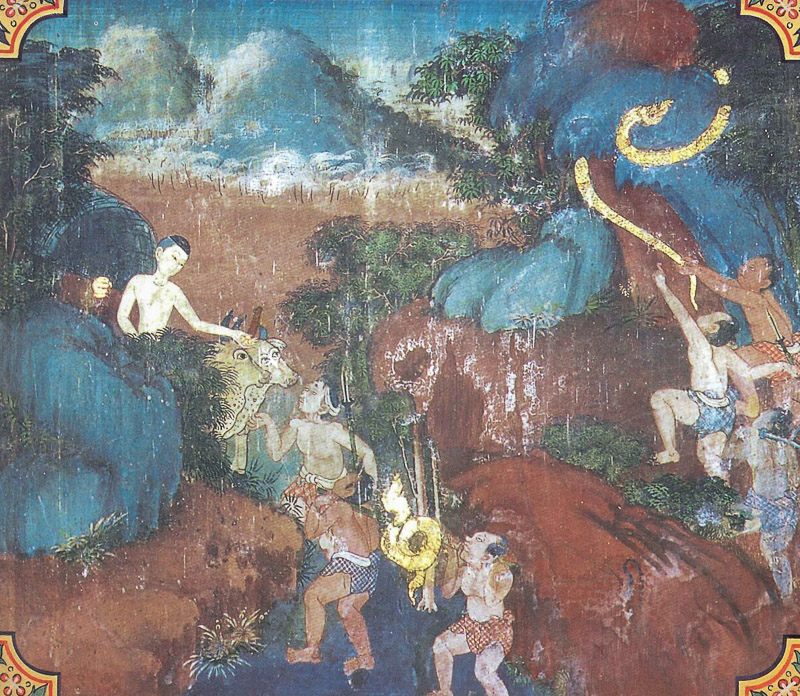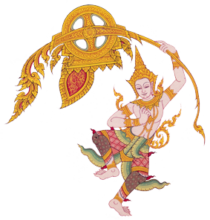
The Bodhisatta was once a human king and then a naga king in back-to-back lives. His father had abdicated the throne and lived as an ascetic in the royal park, and the newly crowned Bodhisatta visited him three times a day. Unable to develop his mystic meditation because of the constant distraction, the father moved far away without telling anyone. And living alone in a leaf hut and eating foods from the forest, he finally mastered it.
Some time later, the Bodhisatta sought out his father, and eventually found him. When he arrived, his father was teaching dharma to a naga king and some of his subjects. The Bodhisatta was so taken by the nagas’ magnificence that he desired nothing more than rebirth in the naga world for his next life. After spending a few days with his father, he returned to the kingdom where he never strayed from moral law, faithfully observed the holy days, and built alms halls at each of the four city gates, becoming known throughout India for his generosity. And because he lived such a righteous life, his wish came true, and he was reborn as a naga king.
Over time, the Bodhisatta grew bored with the naga realm’s grandeur, and he wanted his next life to be as a human again. He tried to keep the holy-day vows and live a moral life, but he was not very successful due to the myriad temptations always around him. So, despite the danger of being captured and killed, he began to spend the holy days in the human realm atop an anthill, where he would not be distracted.
One day, while the Bodhisatta was lying on his anthill, sixteen hunters from a nearby village saw him. The Bodhisatta heard them approaching and opened his eyes, but wanting to remain firm in his righteousness, he did nothing to resist and refused to get angry. The hunters pulled his tail to stretch his massive body out along the ground, pierced him with stakes, shoved bamboo poles through his body, and dragged him off with ropes.
A wealthy landowner riding by in his carriage saw the hunters and their prey and paid them each a handful of gold coins, an ox, and fancy clothes to release the Bodhisatta. As a reward, the Bodhisatta invited his rescuer to come live in his heavenly palace with three hundred naga maidens to serve him. The landowner stayed in the naga realm for a year, but then left to live as an ascetic in the Himalayas.
Once when the ascetic went on a pilgrimage down to the city, he stayed in the royal park. The king saw the ascetic during his morning alms round and, impressed by his demeanor, served him a variety of fancy food in the palace. After eating, he told the king how saving the Bodhisatta’s life had led him to renounce the world and become an ascetic. Then he preached about the impermanence of all things to the king, who accepted his message and lived a righteous, generous life. At the end of the rainy season, the ascetic returned to his Himalayan home.
In the Lifetime of the Buddha
One time the Buddha praised some lay followers for observing the holy days and told them this story to show that doing so can bring great rewards.
The Bodhisatta’s father, the king at the end of the story, and the landowner were earlier births of Maha Kassapa, Ananda, and Sariputta, three of the Buddha’s top disciples.
